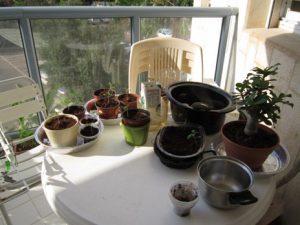
Houseplants filter air pollution. But there are other things you can do to make sure your indoor space is healthy.
Indoor air quality is often worse than that of the outside air. That’s tragic that we may spend half or more of our time inside of our homes. Yet we consume energy trying to maintain the comfort of our homes and opening a window to let in fresh air wastes electricity. What is the solution? Here are a few tips for improving the air quality and energy efficiency of your home.
Invest in AC Maintenance
Regularly changing out the air filters in the AC won’t just improve your indoor air quality. It will reduce the wear and tear on the air conditioner motor, extending its life. Cleaning the vents and the condenser coil will improve the unit’s efficiency. This will help you lower your energy bill while keeping cool. More importantly, it will allow technicians to inspect for coolant leaks. They can fix refrigerant leaks before they result in a hot compressor burning out, and it minimizes the environmental impact such leaks can cause.
What can you do if you aren’t having the AC checked out two to four times a year? Call out a San Antonio AC repair service as soon as your AC is having problems, so that the minor issues can be addressed before they become expensive failures.
Take Care of Your Ductwork
In many homes, heated and cooled air is distributed through the home via ductwork. Dust may stick to the inside of the ductwork. This won’t necessarily get into the air if you turn up the fan, but it can impair the proper flow of air inside your home. The ducts may be trapping moisture. If there is mold growing on the inside of the ducts, you need to have them professionally cleaned to get rid of the mold. That has the side benefit of reducing respiratory problems airborne mold can cause. Have the ducts inspected periodically. Gaps and breaks in the seal let air-conditioned air escape. That is always a waste of energy, and these breaks in the system provide pests a way into your home.
Choose Permanent Solutions to Long-Term Problems
Always try to resolve the root cause of a problem, instead of resorting to temporary fixes. For example, you should have your ducts cleaned or the water leak contributing to mold growth fixed rather than spraying deodorizer in the air. You may need to remove the bushes intended to hide the air conditioner from view so that the unit has adequate air flow. While Texas rarely gets cold enough to justify having a dedicated furnace, a clogged drain in a furnace can result in the whole house smelling like mold and mildew. Fixing the drainage problem could eliminate the odor. In San Antonio, AC drain pans that can’t drain properly can cause a similar issue.
On the other hand, a bad smell that starts every time you turn on the AC could be due to mold growing in the HVAC filter you haven’t gotten around to changing. If you have bad allergies, invest in HEPA grade filters and change them regularly. If most people change their HVAC filters two or three times a year, consider replacing HEPA filters at least four times a year. Replacing the filters more often so that the AC doesn’t have to work as hard to pull in air will lower your electric bill and reduce wear and tear on the equipment.



